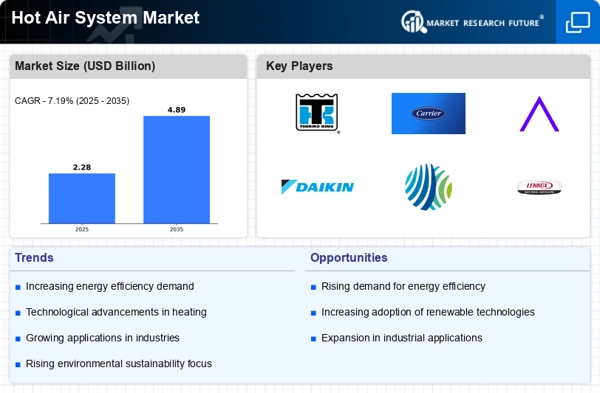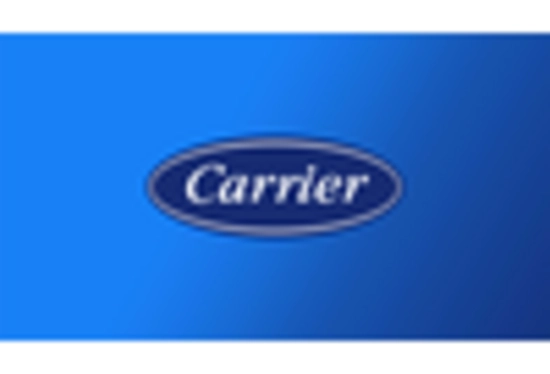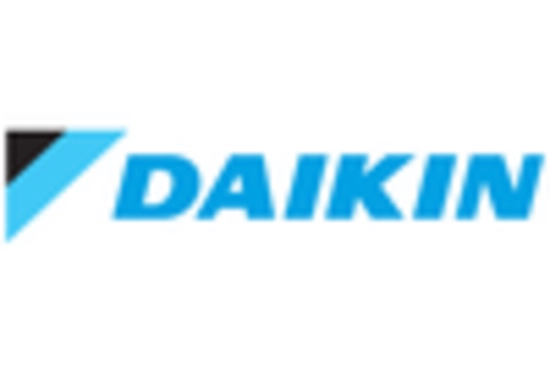Technological Innovations
Technological advancements are reshaping the Hot Air System Market, leading to the development of more efficient and user-friendly systems. Innovations such as smart controls, enhanced insulation materials, and advanced heat exchangers are becoming increasingly prevalent. These technologies not only improve the performance of hot air systems but also contribute to their sustainability by reducing emissions and energy consumption. Market data indicates that the integration of IoT and automation in heating systems is gaining traction, allowing for real-time monitoring and optimization of energy use. As these technologies continue to evolve, they are expected to drive further growth in the hot air system market, attracting both new and existing players.
Growing Focus on Sustainability
The heightened focus on sustainability is driving changes in the Hot Air System Market. As businesses and consumers become more environmentally conscious, there is a growing preference for heating solutions that minimize environmental impact. Hot air systems, which can be designed to operate with renewable energy sources, are increasingly viewed as a sustainable option. Market trends indicate that companies are actively seeking to reduce their carbon footprints, and hot air systems offer a viable solution to achieve these goals. This shift towards sustainability is likely to enhance the attractiveness of hot air systems, encouraging more industries to adopt these technologies as part of their commitment to environmental stewardship.
Expanding Industrial Applications
The versatility of hot air systems is a key driver for their growth in the Hot Air System Market. These systems are increasingly being utilized across various sectors, including food processing, textiles, and pharmaceuticals, due to their ability to provide consistent and controlled heating. The food industry, for example, relies on hot air systems for drying and cooking processes, which are essential for maintaining product quality and safety. Market data reveals that the food processing sector is one of the largest consumers of hot air systems, contributing significantly to market expansion. As industries continue to explore innovative applications for hot air systems, their market presence is expected to broaden, leading to increased demand.
Rising Demand for Energy Efficiency
The increasing emphasis on energy efficiency is a pivotal driver for the Hot Air System Market. As industries and consumers alike seek to reduce energy consumption and lower operational costs, hot air systems are being recognized for their ability to provide effective heating solutions with minimal energy waste. According to recent data, the energy efficiency market is projected to grow significantly, with hot air systems playing a crucial role in this transformation. This trend is particularly evident in sectors such as manufacturing and agriculture, where efficient heating solutions can lead to substantial cost savings and improved productivity. The growing awareness of energy conservation is likely to propel the adoption of hot air systems, thereby enhancing their market presence.
Regulatory Support for Clean Energy Solutions
Regulatory frameworks promoting clean energy solutions are significantly influencing the Hot Air System Market. Governments worldwide are implementing policies aimed at reducing carbon emissions and promoting energy-efficient technologies. This regulatory support is likely to create a favorable environment for the adoption of hot air systems, which are often seen as a cleaner alternative to traditional heating methods. For instance, incentives for energy-efficient upgrades and stricter emissions standards are encouraging industries to invest in hot air systems. Market analysis suggests that as these regulations become more stringent, the demand for compliant heating solutions will increase, further driving the growth of the hot air system market.


















Leave a Comment